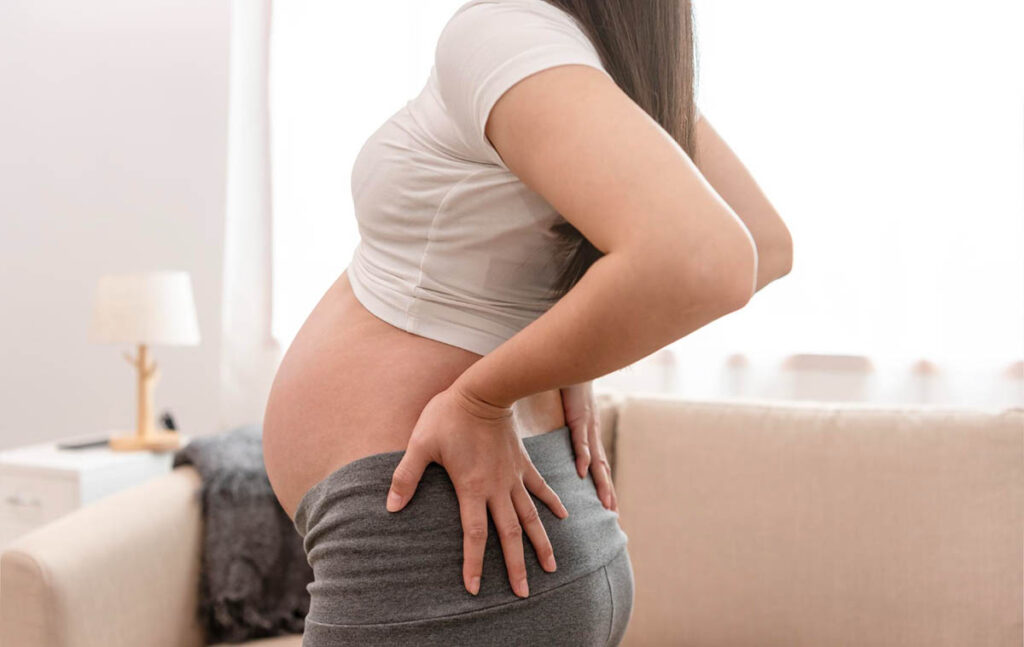Pregnancy is a beautiful and transformative journey, but it’s not without its challenges—upper back pain is one of the most common discomforts expectant mothers face. Hormonal shifts, postural changes, and the physical demands of carrying a growing baby can strain the upper back, leading to aches and tension. Thankfully, with the proper knowledge and proactive strategies, relief is possible. In this comprehensive guide, we’ll delve into the causes of upper back pain during pregnancy, the benefits of physical therapy, effective stretches and exercises, and lifestyle tips to help you navigate this phase with greater comfort and confidence.
Why Upper Back Pain Happens During Pregnancy
Upper back pain during pregnancy is a common issue caused by the body’s natural adjustments to support the growing baby. Hormonal changes, postural shifts, and increased physical demands all contribute to the discomfort many expectant mothers experience.
Hormonal and Physical Changes Contributing to Pain
Hormonal changes during pregnancy, mainly increased relaxin, prepare the body for childbirth by loosening ligaments and joints. While this is essential, it can also destabilize the spine and lead to upper back pain. Additionally, the physical changes, such as a growing belly and shifting center of gravity, strain the back muscles and upper spine.
Common Triggers and Risk Factors
Poor posture, prolonged sitting or standing, and inadequate support during sleep can trigger upper back pain. Risk factors include carrying multiples, pre-existing back issues, and a sedentary lifestyle. Statistics show that prevalence rates of upper back, lower back, and pelvic girdle pain during pregnancy are 42%, 77%, and 74%, respectively, underscoring the need for comprehensive care.
The Role of a Physical Therapist for Back Pain Relief
A physical therapist is crucial in managing and alleviating upper back pain during pregnancy. Addressing the underlying causes and providing personalized care help expectant mothers maintain comfort and mobility throughout this transformative time.
How Physical Therapy Helps During Pregnancy
Physical therapy treatment provides targeted solutions to alleviate back pain. Therapists use techniques such as manual therapy, tailored stretches, and exercises to address pain comprehensively. They also focus on reducing tension in the surrounding muscles and improving spinal alignment.
Benefits of Consulting a Physical Therapist
Consulting a physical therapist during pregnancy offers numerous benefits that go beyond immediate pain relief. Their expertise in creating personalized treatment plans ensures safe and effective care, helping to improve posture, strengthen the core, and reduce the risk of chronic pain after childbirth.
Finding a Physical Therapist for Back Pain Near You
Selecting the right physical therapist is essential for safe and effective back pain relief during pregnancy. Vitality Therapy and Performance is a trusted provider specializing in pregnancy and postpartum care. Their team of experts designs personalized treatment plans to address the unique challenges of pregnancy, ensuring safe and targeted relief.
At Vitality Therapy and Performance, expectant mothers benefit from advanced techniques such as manual therapy, tailored exercises, and posture correction to alleviate upper back pain and support overall well-being. By focusing on pregnancy and postpartum care, they help you stay comfortable and confident throughout your journey. To start your path to relief, visit their clinic or search for “physical therapist for back pain near me” to find trusted professionals in your area.
Effective Pregnancy Stretches for Back and Hip Pain
Pregnancy stretches are a safe and effective way to relieve upper back and hip pain while improving flexibility and circulation. Incorporating targeted stretches into your routine can help reduce muscle tension and support overall comfort during this transformative time.
Stretching to Alleviate Tension and Improve Flexibility
Stretching is a simple yet powerful way to alleviate tension and improve flexibility in the upper back during pregnancy. Promoting better circulation helps relieve discomfort and supports the body as it adapts to the physical changes of pregnancy.
Step-by-Step Guide to the Best Pregnancy Stretches

When done correctly, pregnancy stretches can be both relaxing and effective in relieving upper back pain. Below is a step-by-step guide to some of the best stretches designed to ease tension, improve flexibility, and support your body during pregnancy.
- Cat-Cow Stretch
- Start on all fours.
- Inhale, arch your back (Cow pose).
- Exhale, round your spine (Cat pose).
- Repeat for 8-10 breaths.
- Child’s Pose with Side Stretch
- Kneel and extend your arms forward on the floor.
- Shift your hips back.
- Reach arms to one side, stretching the opposite side of the upper back.
- Hold for 20-30 seconds on each side.
- Seated Thoracic Stretch
- Sit on a chair with feet flat.
- Cross your arms over your chest and twist gently from side to side.
- Repeat 8-10 times.
Modifications for Safe Stretching During Pregnancy
To ensure safe stretching during pregnancy, avoid lying flat on your back after the first trimester and choose side-lying or seated positions instead. Focus on slow, controlled movements and listen to your body to prevent strain or injury.
Lifestyle Tips for Relieving Upper Back Pain
Simple lifestyle adjustments can significantly improve the management of upper back pain during pregnancy. From maintaining good posture to incorporating supportive tools, these tips can help reduce strain and promote overall comfort.
Maintaining Good Posture for Reduced Strain
Maintaining good posture is essential for reducing strain on your upper back during pregnancy. Keep your shoulders relaxed and pulled back while standing or sitting, and wear supportive footwear to help distribute weight evenly.
Ergonomic Adjustments at Home and Work
Ergonomic adjustments at home and work can significantly reduce upper back pain during pregnancy by minimizing unnecessary strain on your spine. Use a chair with proper lumbar support to maintain the natural curve of your lower back while sitting. Ensure your desk and monitor are at eye level to prevent slouching and neck strain. Additionally, take breaks to move or stretch every 30 minutes, as prolonged sitting or standing can exacerbate discomfort. These small but effective changes can improve posture, support spinal health, and enhance overall comfort during pregnancy.
Using Supportive Equipment Like Pregnancy Pillows
Pregnancy pillows can help alleviate discomfort by supporting your body’s natural curves while you sleep. They reduce strain on the back and hips, promoting better spinal alignment and overall rest quality during pregnancy.
Simple Exercises to Relieve Upper Back Pain
Gentle exercises can effectively manage upper back pain during pregnancy by promoting strength and mobility. Incorporating safe, low-impact movements into your daily routine can provide relief while supporting your body’s changing needs.
Gentle Mobility Exercises for Daily Relief
Gentle mobility exercises are a great way to ease stiffness and improve flexibility in the upper back during pregnancy. These simple movements can be done daily to reduce tension and maintain a healthy range of motion.
- Shoulder Rolls
- Roll shoulders forward and backward in a circular motion for 10 repetitions each.
- Wall Angels
- Stand with your back against a wall.
- Slowly raise and lower your arms like making a snow angel.
- Perform 10 repetitions.
Strengthening the Upper Back Safely
Strengthening the upper back safely during pregnancy helps stabilize the spine and reduce the likelihood of recurring pain. To build strength without overexerting, opt for light resistance bands or bodyweight exercises like rows and scapular squeezes.
Incorporating Low-Impact Cardio for Better Results
Incorporating low-impact cardio activities like walking, swimming, or prenatal yoga can enhance circulation and promote overall well-being during pregnancy. These exercises also release endorphins, the body’s natural painkillers, relieving upper back discomfort.
When to Seek Professional Help for Upper Back Pain

While many cases of upper back pain during pregnancy can be managed with at-home remedies, some situations require professional intervention. Knowing when to seek help can ensure timely treatment and prevent complications, providing better comfort and support throughout pregnancy.
Signs Your Pain Requires Medical Attention
Recognizing that upper back pain may require medical attention is crucial for ensuring maternal and fetal health. Symptoms such as persistent or worsening pain, numbness, or difficulty breathing could indicate an underlying issue that needs immediate evaluation by a healthcare provider.
- Pain that persists or worsens despite home remedies
- Numbness, tingling, or weakness in the arms
- Difficulty breathing or sharp chest pain
Exploring Advanced Therapies for Chronic Pain
Advanced therapies can provide targeted relief for chronic upper back pain during pregnancy. Clinics like Vitality Therapy and Performance offer dry needling, manual therapy, and other specialized techniques to address persistent discomfort safely and effectively.
What to Expect from Physical Therapy Sessions
Physical therapy sessions for upper back pain during pregnancy begin with a thorough assessment to identify the root cause of discomfort. Therapists then provide personalized exercises, hands-on techniques, and at-home strategies to support ongoing relief and improve overall mobility.
Preventing Upper Back Pain During Pregnancy
Preventing upper back pain during pregnancy involves proactive measures to support your body’s changing needs. By incorporating safe exercises, maintaining good posture, and balancing activity with rest, you can reduce the likelihood of discomfort and promote a healthier pregnancy experience.
Developing a Personalized Exercise Plan
Collaborating with a physical therapist allows you to create a customized exercise plan tailored to your needs during pregnancy. These plans emphasize building strength and flexibility to support your changing body and minimize back pain.
Balancing Rest and Activity
Striking the right balance between rest and activity prevents upper back pain. Avoid prolonged inactivity by incorporating gentle movements throughout the day while prioritizing adequate rest to recharge your body.
Staying Consistent with Prenatal Care
Regular prenatal care visits help identify potential risk factors for back pain early, ensuring you receive appropriate guidance and intervention. Staying consistent with these check-ups supports a healthy and more comfortable pregnancy journey.
Conclusion
Upper back pain during pregnancy is common but manageable with the right approach. Understanding the causes, consulting a skilled physical therapist, and incorporating targeted stretches, exercises, and lifestyle adjustments can significantly improve comfort. Consistent prenatal care and proactive strategies help you navigate pregnancy with ease, allowing you to focus on the joy of this transformative journey.
FAQs
What can I do to relieve upper back pain during pregnancy?
To manage upper back pain during pregnancy, try incorporating stretches like the Cat-Cow pose to alleviate tension and improve flexibility. Maintaining good posture and consulting a physical therapist for personalized guidance can also provide significant relief.
Is it safe to use a heating pad on your back while pregnant?
A heating pad is generally safe during pregnancy if set to a low temperature and used for short durations. Avoid prolonged exposure to ensure your body doesn’t overheat, which could affect you and your baby.
How do you stretch your upper back when pregnant?
Gentle stretches, such as Child’s Pose or a seated thoracic stretch, are safe and effective for relieving upper back tension during pregnancy. They help loosen tight muscles and improve circulation without putting unnecessary strain on the body.

